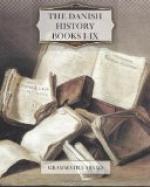Magic was powerful enough even to raise the dead, as was practised by the Perms, who thus renewed their forces after a battle. In the Everlasting battle the combatants were by some strange trick of fate obliged to fulfil a perennial weird (like the unhappy Vanderdecken). Spells to wake the dead were written on wood and put under the corpses’ tongue. Spells (written on bark) induce frenzy.
“Charms” would secure a man against claw or tooth.
“Love philtres” (as in the long “Lay of Gudrun) appear as everywhere in savage and archaic society.
“Food”, porridge mixed with the slaver of tortured snakes, gives magic strength or endues the eater with eloquence and knowledge of beast and bird speech (as Finn’s broiled fish and Sigfred’s broiled dragon-heart do).
“Poison” like these hell-broths are part of the Witch or Obi stock-in-trade, and Frode uses powdered gold as an antidote.
“Omens” are observed; tripping as one lands is lucky (as with our William the Norman). Portents, such as a sudden reddening of the sea where the hero is drowned, are noticed and interpreted.
“Dreams” (cf. Eddic Lays of Attila, and the Border ballads) are prophetic (as nine-tenths of Europeans firmly believe still); thus the visionary flame-spouting dragon is interpreted exactly as Hogne’s and Attila’s dreams. The dreams of the three first bridals nights (which were kept hallowed by a curious superstition, either because the dreams would then bold good, or as is more likely, for fear of some Asmodeus) were fateful. Animals and birds in dreams are read as persons, as nowadays.
A “curse” is powerful unless it can be turned back, when it will harm its utterer, for harm someone it must. The “curse” of a dying man on his slayer, and its lack of effect, is noted.
Sometimes “magic messengers” are sent, like the swans that bore a token and uttered warning songs to the hero.
“Witches and wizards” (as belonging to the older layer of archaic beliefs) are hateful to the gods, and Woden casts them out as accursed, though he himself was the mightiest of wizards. Heathen Teutonic life was a long terror by reason of witchcraft, as is the heathen African life to-day, continual precautions being needful to escape the magic of enemies. The Icelandic Sagas, such as Gretter’s, are full of magic and witchcraft. It is by witchcraft that Gretter is first lamed and finally slain; one can see that Glam’s curse, the Beowulf motif, was not really in the original Gretter story.
“Folk-medicine” is really a branch of magic in old days, even to such pioneers of science as Paracelsus.
Saxo’s traditions note drinking of a lion’s blood that eats men as a means of gaining might and strength; the drinking of bear’s blood is also declared to give great bodily power.
The tests for “madness” are of a primitive character, such as those applied to Odusseus, who, however, was not able, like Hamlet, to evade them.




